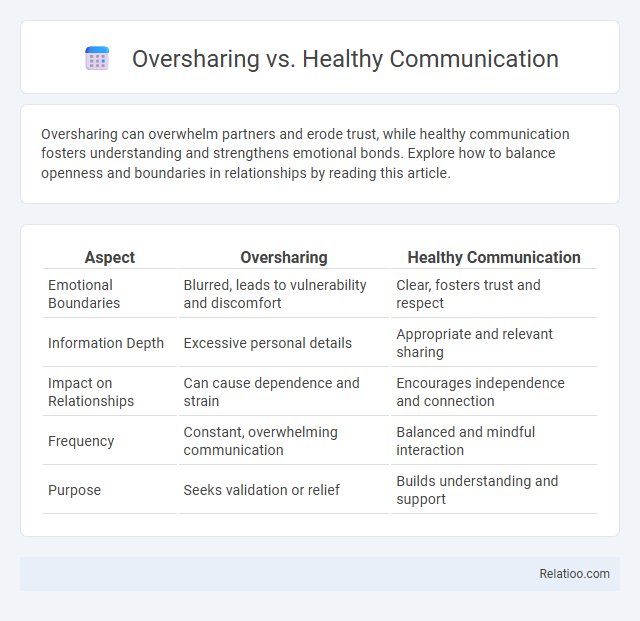Oversharing can overwhelm partners and erode trust, while healthy communication fosters understanding and strengthens emotional bonds. Explore how to balance openness and boundaries in relationships by reading this article.
Table of Comparison
| Aspect | Oversharing | Healthy Communication |
|---|---|---|
| Emotional Boundaries | Blurred, leads to vulnerability and discomfort | Clear, fosters trust and respect |
| Information Depth | Excessive personal details | Appropriate and relevant sharing |
| Impact on Relationships | Can cause dependence and strain | Encourages independence and connection |
| Frequency | Constant, overwhelming communication | Balanced and mindful interaction |
| Purpose | Seeks validation or relief | Builds understanding and support |
Understanding Oversharing: Definition and Signs
Oversharing occurs when personal information is disclosed excessively or inappropriately, often leading to discomfort or boundary violations in relationships. Signs include divulging intimate details too soon, ignoring social cues, and overwhelming others with private matters. Distinguishing oversharing from healthy communication is essential, where the latter involves sharing information thoughtfully and respecting mutual boundaries.
What Constitutes Healthy Communication?
Healthy communication involves sharing relevant thoughts and feelings clearly and respectfully, fostering mutual understanding without invading personal boundaries. It balances openness with discretion, ensuring that Your conversations remain meaningful and appropriate for the context. Oversharing occurs when private information is disclosed excessively or inappropriately, potentially causing discomfort or misunderstanding.
The Fine Line: Oversharing vs Healthy Boundaries
Maintaining healthy communication requires recognizing the fine line between oversharing and establishing personal boundaries, where oversharing involves revealing excessive personal information that can lead to discomfort or vulnerability. Healthy boundaries promote trust and respect by sharing appropriately relevant details suited to the relationship context without compromising privacy or emotional well-being. Navigating this balance enhances emotional intimacy while protecting individual mental health and interpersonal dynamics.
Psychological Reasons Behind Oversharing
Oversharing often stems from psychological needs such as seeking validation, relief from anxiety, or a desire to build intimacy quickly. Healthy communication, in contrast, balances self-disclosure with boundaries, fostering trust and emotional safety without overwhelming the listener. Understanding these underlying psychological motivations helps differentiate between excessive disclosure and meaningful, constructive sharing.
Benefits of Practicing Healthy Communication
Practicing healthy communication enhances emotional clarity by fostering open, respectful dialogue that encourages trust and understanding. It helps establish boundaries, preventing oversharing that can lead to vulnerability or discomfort while ensuring that important feelings and thoughts are effectively conveyed. This balanced approach supports stronger relationships and promotes mental well-being through mutual respect and clear expression.
Risks and Consequences of Oversharing
Oversharing personal information can lead to privacy breaches, damaged relationships, and increased vulnerability to identity theft or manipulation. Maintaining healthy communication requires setting clear boundaries to protect your emotional well-being and prevent misunderstandings. You should carefully consider the risks and potential long-term consequences before disclosing sensitive details in any conversation.
How to Identify Your Communication Style
Identifying your communication style involves assessing how much personal information you share and recognizing whether it fosters understanding or creates discomfort. Oversharing may lead to blurred boundaries and vulnerability, while healthy communication balances openness with respect for privacy. Your ability to gauge these differences ensures more meaningful and effective conversations.
Tips to Transition from Oversharing to Healthy Sharing
Identify your emotional triggers and set boundaries to shift from oversharing to healthy communication, ensuring your conversations remain meaningful and respectful. Practice mindful self-awareness by reflecting on what information truly benefits the listener and supports your well-being. You can enhance your relationships by gradually sharing personal details aligned with trust and context, fostering deeper connections without overwhelming others.
Setting Personal Boundaries for Better Relationships
Setting personal boundaries is essential for distinguishing healthy communication from oversharing, as it helps maintain respect and trust within relationships. Healthy communication involves sharing relevant feelings and experiences without violating privacy or overwhelming others, whereas oversharing often leads to discomfort and blurred boundaries. Establishing clear limits on what and when to share supports emotional well-being and fosters stronger, more balanced connections.
Building Emotional Intelligence in Communication
Building emotional intelligence in communication involves recognizing the fine line between healthy communication and oversharing, ensuring your thoughts and feelings are expressed appropriately without overwhelming others. Developing self-awareness and empathy helps you gauge the right depth and timing of your disclosures, fostering trust and meaningful connections. Mastering this balance sharpens your emotional intelligence, enhancing both personal and professional relationships.

Infographic: Oversharing vs Healthy Communication
 relatioo.com
relatioo.com